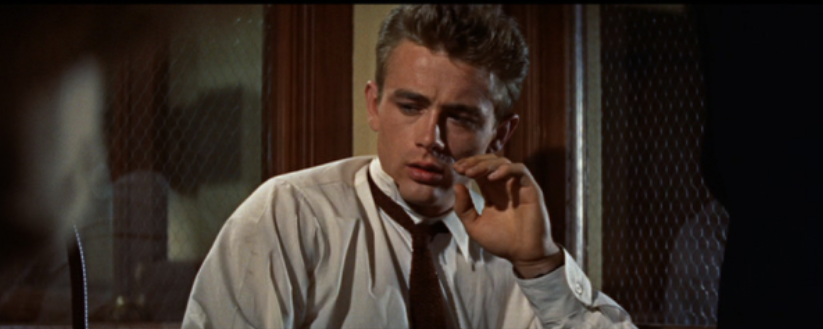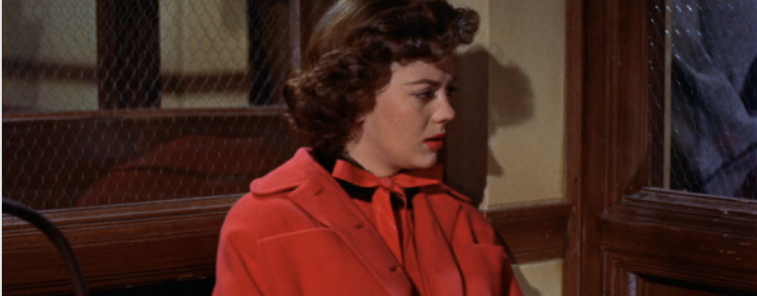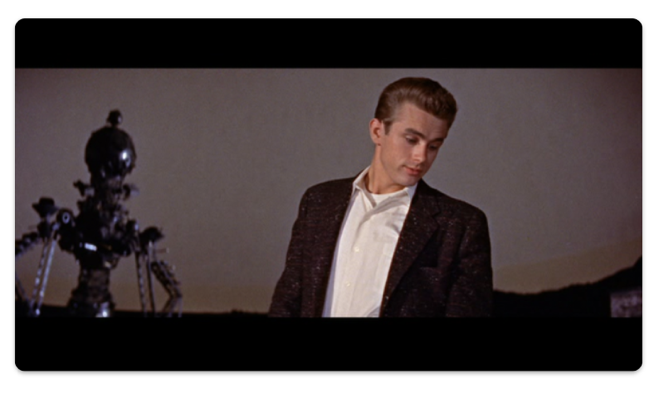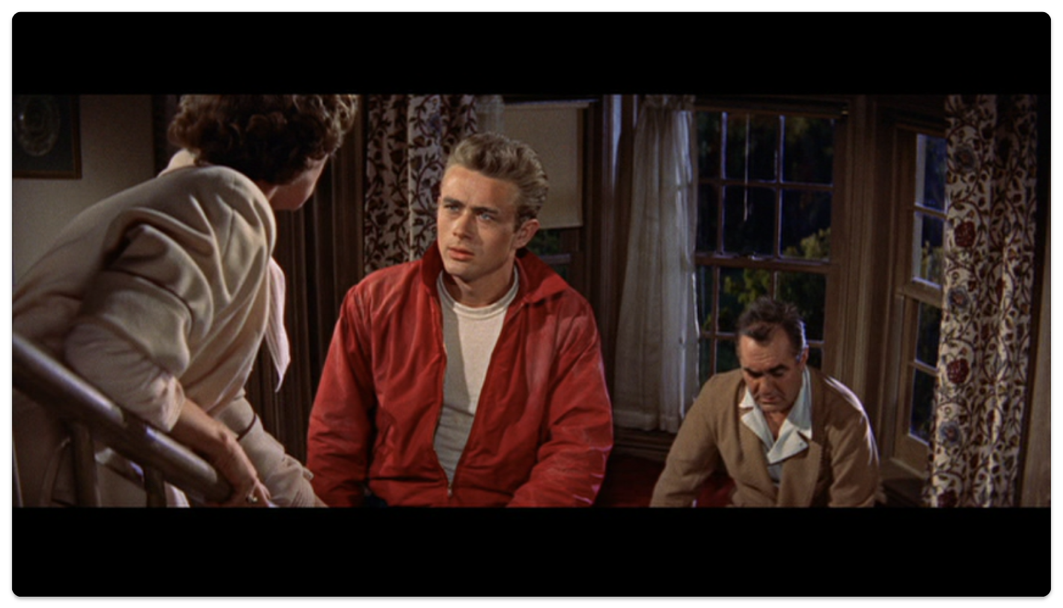Rebel Without a Cause has been praised for capturing the complexity of emotions of an entire teenage generation. The movie has encouraged a wave of teenager dramas, and after the premier, it helped to solidify a completely new market in Hollywood, unique to the otherwise overlooked teenage demographic. Throughout the film’s narrative, a group of young people stepping away from childhood and toward adulthood gained a personality and individualism that has never been represented on the screen (Kashner). Teenagers have gained a new niche within their own identity, social rituals, and language, with their characterizations evident from their costumes. As in life, the wardrobe of the main character, Jim Stark, is as defining to his personality as his monologues, with the fashion transforming through the movie to express his feelings.
When the audience first meets Jim at a police station as he finds himself arrested for disorderly conduct and drunkenness, he wears suit bottoms and a white shirt with an untied tie. This implies that when he has left the house to go on a night out in the town, he was wearing a full suit, but then something went wrong. From the very beginning, the choice of wardrobe is used to signify the influence of parents on a young man. They want them to look and act in a proper way, but he rebels again and again. At the station, talking to the officers, Jim loosens his tie and has a heart-to-heart, crying about his negative feelings towards his parents, thus shedding their influence physically while also trying to shed it mentally.
The opening scene described above is instrumental for showing the importance of the connection between a scene’s setting and costuming. Alone, the costuming does not suffice because the way in which characters are dressed only matters in a particular context. Thus, in the initial scene, the protagonist of the movie is depicted sitting in the interrogation room’s corner. Further in the film, Judy is also shown sitting in a detective’s room corner, wearing a full red outfit (see Figure 1). While there is a contrast between their outfits in these specific scenes, the color red is a primary color of the film, as seen time and time again in Jim’s infamous red jacket. Notably, red has different meanings for the different characters of Rebel Without a Cause. For instance, for Jim, the color red signified rebellion against his parents and society overall. For Judy, red meant anger, while in Plato’s case, it represented peace. Even though every character wears red clothing, their alignment with the color is seen at different points throughout the film, Judy wears red during her first scenes, Jim in the middle, and Plato in the finale. Such a progression is essential for offering dimension to the narrative and characters’ unity, which is absent when the film begins.


After some time in the movie, Jim Stark is no longer seen with a tie as he has the initial day at a new school. Getting rid of the time is a notable point because it enables viewers to see the logical progression of the character’s ark (see Figure 2). Jim wants his peers to see himself as an individual with his own unique personality and a vision of the world. This point is also transitional as it shows that Jim has not found himself just yet, and is somewhere in between: he has not abandoned the idea of pleasing his parents while also made several large leaps in the direction of rebellion. Such a juxtaposition is seen is not only in the fashion of the character but also in the battle between individuality and tradition. Jim is concerned with his place in a new group of peers, questions whether he should join them or whether he should oppose them.

The car race scene is one of the most remembered from the movie not only because of the action and drama that ensued but also because Jim wears the bright red jacket for the initial time in the movie. The red jacket is a symbol of the character’s desire to be accepted by the ‘cool kids’ and get into their circle. The rebellious look that Jim gets with the jacket gives him confidence, which is something he lacks at the beginning of the movie. The ambitions that he pursues, however, result in a tragic event, the death of the young man against whom Jim was racing, and he subsequently returns home. Despite the tragedy, Jim gathers all the strength he has and confronts the parents whom he finds useless. Still wearing his red jacket opened up almost all the way, Jim stands out against the beige surroundings of his parents’ house. The confrontation represents a long-standing conflict between parents and children. The ability of Jim to stand up for himself is also represented by his collar pointing upward, signifying defiance (see Figure 3). The confrontation scene is crucial to the process of Jim’s identity development. Standing up for himself, the young man looks much stronger compared to the hunched figure of his father behind him. The overbearing mother stands higher up than Jim, which causes him to look up in a defiant pose.

Developing his confidence and a sense of self-worth, Jim becomes strong enough to assume the role of Plato’s caretaker. Jim and Judy play the troubled young man’s parents whose birth parents have been replaced by a continuously concerned housekeeper. In the attempt to save Plato from killing himself at the planetarium, Jim uses the confidence that he has attained and aims to transfer it to another person. In the rooftop scene, when Jim sees the boy shivering from the cold, he offers him a jacket as a way to make Plato give up his gun. The latter asks with awe if he could keep the jacket, which underlines the symbolic strength that the garment exudes. The simple gesture of giving away his item of clothing is two-dimensional. First, the young man offers Plato an object that signifies his acceptance of the troubled friend and the support he has for him. Second, Jim does not need the jacket anymore as he finally understood who he was as a person, with or without a stylish clothing item.
The red jacket remains present in the final scenes of the movie, which points to its overall importance to the narrative and character development. As the audience sees the characters of the movie gather over Plato’s body, the young man is still wearing Jim’s jacket that he was gifted. The scene is very important because it shows probably the first time in the movie when Jim introduces his parents to his friends, opening a new chapter in the relationship with his family (Fulmer 665). At this point, Jim manages to separate himself from the rebellious adolescence metaphorically. An important observation is that even Jim’s father acknowledges the fact that his son is no longer a child, making a comment that he did everything a man would do to save his friend. Therefore, Jim’s jacket plays a role of not only a confidence booster but also represents the young man’s entry into adulthood.
Rebel Without a Cause is the first Hollywood coming of age story that has transcended generations and generations of young people who are just starting to find their life path. It includes many of the things that can occur in the years of growing up, such as romance, rebellion, family drama, and reckless acts. The costume choices for the main character have shown to play an important part in the storytelling, illustrating his personal development, making steps in the direction of adulthood. Although the movie does not make it evident that clothing plays a part in the story, the subtle use of Jim’s red jacket as a symbol of strength and confidence shows that teenagers would place importance on their image. The same way in which a person would put on their favorite sweater to go on a first date to feel more confident, Jim wore the red jacket because it reflected his inner successes and failures.
Works Cited
Fulmer, Richard. “Rebel Without A Cause: A Psychoanalytic and Family-Life-Cycle View of Emerging Adulthood in the Film.” The Psychoanalytic Quarterly, vol. 86, no. 3, 2017, pp. 665-691.
Kashner, Sam. “Dangerous Talents.” Vanity Fair, 2005.